SANGUINARINE
- CAS NO.:2447-54-3
- Empirical Formula: C20H14NO4
- Molecular Weight: 332.33
- MDL number: MFCD00064925
- EINECS: 219-503-3
- SAFETY DATA SHEET (SDS)
- Update Date: 2024-11-19 23:02:33
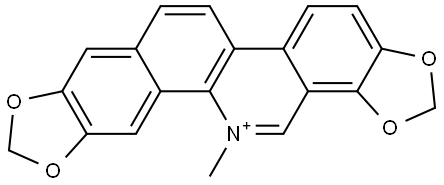
What is SANGUINARINE?
Description
A naphthoisoquinoline alkaloid, this base occurs in the roots of Chelidonium majus L., Glaucium fimbrilligerum and Sanguinaria canadensis L. The alkaloid was stated by Schmidt, Konig and Tietz to crystallize from EtOH or AcOEt as colourless needles, m.p. 213°C but this low melting point was found to be due to the presence of chelerythrine as an impurity. Once this is removed as the pseudocyanide, the base crystallizes from Et20 and has the above melting point or 242-3°C on slow heating. Obtained from EtOH it forms the alcoholate, m.p. 195-7°C. The hydrochloride forms long, slender, bloodred needles. On distillation with Zn dust, the alkaloid furnishes a-naphthaphenanthridine and the structure given above has been further confirmed by synthesis.
Description
Sanguinarine is an antimicrobial used in mouthwashes and toothpaste to guard against inflammation brought on by gingivitis. Is has also been found to protect against skin cancer by enhancing the production of proteins that induce the death of cells damaged by UV-B radiation.
The Uses of SANGUINARINE
Sanguinarium induces HO-1 expression thus inhibiting MMP-9 and COX-2 expression in TPA-induced breast cancer cells.
Definition
Sanguinarine is a benzophenanthridine alkaloid derived from the root of Sanguinaria canadendid. Limited available evidence indicates that it may be used to prevent and treat UV-induced skin damage. Specifically, topical application of sanguinarine on the skin of SKH-1 hairless mice before or after UVB irradiation resulted in significantly lower UVB-mediated skin edema, skin hyperplasia and infiltration of leukocytes, and markers of oxidative stress (e.g., H2O2).
References
Dana., Mag. Pharm., 23, 125 (1829)
Bruchhausen, Bersch., Ber., 63, 2520 (1930)
Spath, Kuffner., ibid, 64, 370, 1123, 2034 (1931)
Synthesis:
Dyke, Moon, Sainsbury., Tetrahedron Lett., 3933 (1968)
Properties of SANGUINARINE
| Melting point: | 205-215°C |
| Boiling point: | 483.53°C (rough estimate) |
| Density | 1.3463 (rough estimate) |
| refractive index | 1.5180 (estimate) |
| storage temp. | Keep in dark place,Sealed in dry,Room Temperature |
| solubility | Chloroform (Slightly), DMSO (Slightly) |
| form | Solid |
| color | White |
Safety information for SANGUINARINE
Computed Descriptors for SANGUINARINE
New Products
4-AMINO-TETRAHYDRO-PYRAN-4-CARBOXYLIC ACID HCL 4-(Dimethylamino)tetrahydro-2H-pyran-4-carbonitrile 4-Aminotetrahydropyran-4-carbonitrile Hydrochloride (R)-3-Aminobutanenitrile Hydrochloride 3-((Dimethylamino)methyl)-5-methylhexan-2-one oxalate 1,4-Dioxa-8-azaspiro[4.5]decane 5-Bromo-2-nitropyridine Nimesulide BP Aceclofenac IP/BP/EP Diclofenac Sodium IP/BP/EP/USP Mefenamic Acid IP/BP/EP/USP Ornidazole IP Diclofenac Potassium THOMAIND PAPER PH 2.0 TO 4.5 1 BOX BUFFER CAPSULE PH 9.2 - 10 CAP SODIUM CHLORIDE 0.1N CVS ALLOXAN MONOHYDRATE 98% PLATINUM 0.5% ON 3 MM ALUMINA PELLETS (TYPE 73) LITHIUM AAS SOLUTION 2-Bromo-1-(bromomethyl)-3-chloro-5-nitrobenzene 2-Bromo-3-nitroaniline N-(3-Hydroxypropyl)-N-methylacetamide 3-Bromo-6-chloropyridazine 4-ethyl-3-nitrobenzoic acidRelated products of tetrahydrofuran



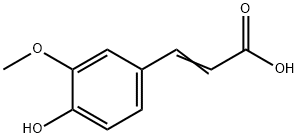
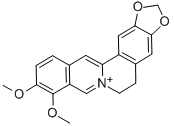

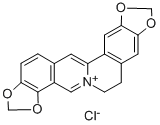
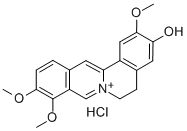
You may like
-
 Sanguinarine chloride 98% (HPLC) CAS 2447-54-3View Details
Sanguinarine chloride 98% (HPLC) CAS 2447-54-3View Details
2447-54-3 -
 1-Methyl-6-oxo-1,6-dihydropyridazine-3-carbonitrile 98%View Details
1-Methyl-6-oxo-1,6-dihydropyridazine-3-carbonitrile 98%View Details
99903-60-3 -
 1823368-42-8 98%View Details
1823368-42-8 98%View Details
1823368-42-8 -
 2-(3-(tert-butyl)phenoxy)-2-methylpropanoic acid 1307449-08-6 98%View Details
2-(3-(tert-butyl)phenoxy)-2-methylpropanoic acid 1307449-08-6 98%View Details
1307449-08-6 -
 Ethyl 3-(furan-2-yl)-3-hydroxypropanoate 25408-95-1 98%View Details
Ethyl 3-(furan-2-yl)-3-hydroxypropanoate 25408-95-1 98%View Details
25408-95-1 -
 2-Chloro-5-fluoro-1-methoxy-3-methylbenzene 98%View Details
2-Chloro-5-fluoro-1-methoxy-3-methylbenzene 98%View Details
1805639-70-6 -
 1784294-80-9 98%View Details
1784294-80-9 98%View Details
1784294-80-9 -
 Lithium ClavulanateView Details
Lithium ClavulanateView Details
61177-44-4